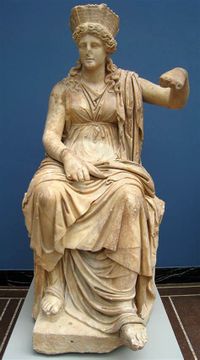Cybele
The goddess was known among the Greeks as Μήτη" (Mētēr "Mother") or Μήτη" Ὀ"εία ("Mountain-Mother"), or, with a particular Anatolian sacred mountain in mind, Idaea, inasmuch as she was supposed to have been born on Mount Ida in Anatolia, or equally Dindymene or Sipylene, with her sacred mountains Mount Dindymon (in Mysia and variously located) or Mount Sipylus in mind. In Roman mythology, her equivalent was Magna Mater or "Great Mother". In most mythology her story is Phrygian.
Her Ancient Greek title, Potnia Theron, also associated with the Minoan Great Mother, alludes to her Neolithic roots as the "Mistress of the Animals". She is associated with her lion throne and her chariot drawn by lions.
Walter Burkert, who treats Cybele among "foreign gods" in Greek Religion, notes that "The cult of the Great Mother, Meter, presents a complex picture insofar as indigenous, Minoan-Mycenean tradition is here intertwined with a cult taken over directly from the Phrygian kingdom of Asia Minor". The inscription matar occurs frequently in her Phrygian sites (Burkert). Kubileya is usually read as a Phrygian adjective "of the mountain", so that the inscription may be read Mother of the Mountain, and this is supported by Classical sources (Roller 1999, pp. 67–68). Another theory is that her name can be traced to the Luwian Kubaba, the deified queen of the Third Dynasty of Kish worshiped at Carchemish and Hellenized to Kybebe (Munn 2004, Motz 1997, pp. 105–106). With or without the etymological connection, Kubaba and Matar certainly merged in at least some aspects, as the genital mutilation later connected with Cybele's cult is associated with Kybebe in earlier texts, but in general she seems to have been more a collection of similar tutelary goddesses associated with specific Anatolian mountains or other localities, and called simply "mother" (Motz).
Later, Cybele's most ecstatic followers were males who ritually castrated themselves, after which they were given women's clothing and assumed female identities, who were referred to by one 3rd-century commentator, Callimachus, in the feminine as Gallai, but to whom other contemporary commentators in ancient Greece and Rome referred to as Gallos or Galli.
There is no mention of these followers in Classical references although they related that her priestesses led the people in orgiastic ceremonies with wild music, drumming, dancing, and drinking. She was associated with the mystery religion concerning her son, Attis, who was castrated, died of his wounds, and resurrected by his mother. The dactyls were part of her retinue.
Other followers of Cybele, the Phrygian kurbantes or Corybantes, expressed her ecstatic and orgiastic cult in music, especially drumming, clashing of shields and spears, dancing, singing, and shouting-all at night.
Chat rooms • What links here • Copyright info • Contact information • Category:Root
